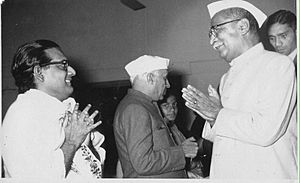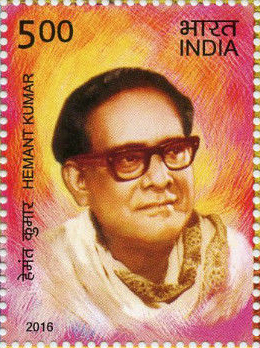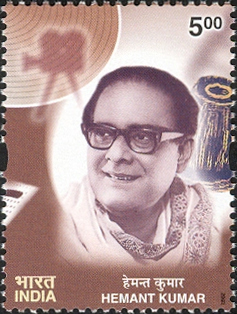Hemant Kumar facts for kids
Quick facts for kids
Hemant Kumar
|
|
|---|---|
 |
|
| Background information | |
| Birth name | Hemanta Kumar Mukhopadhyay |
| Born | 16 June 1920 Benares, Benares State, British India |
| Died | 26 September 1989 (aged 69) Calcutta, West Bengal, India |
| Genres | Film Music, Rabindra sangeet |
| Occupation(s) | Singer, music director, producer |
| Instruments | Harmonium |
| Years active | 1935–1989 |
Hemant Kumar (born Hemanta Mukhopadhyay, 16 June 1920 – 26 September 1989) was a very famous Indian singer and music director. He sang in many different Indian languages. These included Bengali, Hindi, Marathi, Gujarati, Odia, and Tamil.
Hemant Kumar was known for his beautiful voice in film music. He also sang many Rabindra Sangeet songs. These are songs written by the famous poet Rabindranath Tagore. He won two National Film Awards for being the Best Male Playback Singer.
Contents
Early Life and Dreams
Hemanta was born in Varanasi, India. His family later moved to Kolkata in the early 1900s. He grew up there and went to school in the Bhawanipore area.
At school, he became good friends with Subhas Mukhopadhyay. Subhas later became a famous Bengali poet. Hemanta also befriended the writer Santosh Kumar Ghosh. In their youth, Hemanta wrote stories, Santosh wrote poems, and Subhas sang songs.
After finishing high school, Hemanta started studying engineering. But he soon left college to follow his dream of making music. His father was not happy about this choice. For a short time, he even tried writing stories for a magazine. But by the late 1930s, he decided to focus only on music.
Starting His Music Journey
Hemanta recorded his first song for All India Radio in 1935. This was a big step for him. A Bengali musician named Sailesh Duttagupta helped him a lot in his early career.
Hemanta used to look up to the famous singer Pankaj Mullick. People even called him "Chhoto Pankaj," meaning "Little Pankaj." He also learned some classical music.
In 1937, Hemanta released his first record. It was a "gramophone disc" with two non-film songs. He continued to record many non-film songs every year. His first Hindi songs came out in 1940.
Hemanta sang his first film song in 1941. It was for the Bengali movie Nimai Sanyas. He started composing his own songs in 1944. His first Hindi film songs were in the movie Irada (1944 film).
He is considered one of the best singers of Rabindra Sangeet. He recorded his first Rabindra Sangeet for a film in 1944. Later that year, he released his first non-film Rabindra Sangeet record.
Hemanta's first movie as a music director was Abhiyatri in 1947. Even though many of his early songs were liked by critics, he didn't become widely popular until 1947.
Family Life
Hemanta had three brothers and one sister. His older brother, Tarajyoti, was a short-story writer. His youngest brother, Amal Mukherjee, was also a singer and composer.
In 1945, Hemanta married Bela Mukherjee, who was also a singer. Bela sang some popular songs before marriage. But she stopped her music career after they got married.
They had two children, a son named Jayant and a daughter named Ranu. Ranu also became a singer for a while. Jayant married Moushumi Chatterjee, a popular Indian film actress from the 1970s.
Becoming Famous and Moving to Mumbai
In the mid-1940s, Hemanta joined the Indian People's Theatre Association (IPTA). This group used art to raise awareness about social issues. He worked closely with songwriter Salil Chowdhury there. The IPTA was formed partly because of the terrible Bengal famine of 1943.
In 1947, Hemanta recorded a very popular song called "Ganyer badhu." This song was about a rural woman's life. It showed how famine and poverty affected her family. This song made Hemanta and Salil very famous in eastern India. They worked together on many more popular songs.
Around this time, Hemanta started getting more work as a music composer for Bengali films. A director named Hemen Gupta asked him to compose music for his first Hindi film, Anandmath. So, Hemanta moved to Mumbai in 1951. He named his new house "Gitanjali" after a famous work by Rabindranath Tagore.
The music for Anand Math (1952) was quite successful. Hemanta also became popular in Mumbai as a playback singer. This means he sang songs for actors to lip-sync in movies. He sang many hit songs for actor Dev Anand. He also sang for other actors like Pradeep Kumar and Sunil Dutt.
Peak of His Career
By the mid-1950s, Hemanta was a top singer and composer. In Bengal, he was one of the best at singing Rabindra Sangeet. In Mumbai, he became a well-known composer.
He composed music for the Hindi film Nagin (1954). The songs from this movie were huge hits for two years. Hemanta won the Filmfare Best Music Director Award in 1955 for Nagin.
That same year, he composed music for the Bengali movie Shapmochan. He sang four songs for the actor Uttam Kumar in this film. This started a long and very successful partnership between Hemanta and Uttam Kumar. They became the most popular singer-actor pair in Bengali cinema.
In the late 1950s, Hemanta composed and sang for many Bengali and Hindi films. He also recorded many Rabindra Sangeet and non-film songs. Most of his Bengali songs from this time became very popular. This period was the peak of his career.
Producing Movies
In the late 1950s, Hemanta started his own movie production company. It was first called Hemanta-Bela productions. Their first movie was a Bengali film called Neel Akasher Neechey (1959). This movie won the President's Gold Medal, which is a top honor in India.
Later, his company was renamed Geetanjali productions. It made several Hindi movies. Hemanta composed the music for all of them. Two of these movies, Bees Saal Baad and Khamoshi, were very successful.
In 1963, Hemanta composed music for the Bengali film Palatak. He tried mixing folk music with light music, and it was a big hit. His music style changed for many of his later Bengali films.
In 1961, he recorded many Rabindrasangeet songs to celebrate Rabindranath Tagore's 100th birthday. These recordings were also very popular. Hemanta also went on concert tours to other countries. He remained a leading male singer in Bengal and a respected composer and singer in Hindi films throughout the 1960s.
He was a main voice in many of Tagore's musical plays. Along with Kanika Bandopadhyay and Suchitra Mitra, he was part of a famous trio of Rabindra Sangeet singers. People called them 'Hemanta-Kanika-Suchitra'.
Later Years
In the 1970s, Hemanta did less work in Hindi films. He composed music for some of his own movies, but they were not very successful. However, in Bengal, he remained a top singer of Rabindra Sangeet and other songs. His music continued to be popular.
In 1971, Hemanta also tried directing a Bengali movie called Anindita. It did not do very well. In the same year, he went to Hollywood to compose music for the film Siddhartha. He was the first Indian singer to sing in a Hollywood movie. The US government even gave him honorary citizenship of Baltimore, Maryland.
In the early to mid-1970s, two important music composers in Bengal, Nachiketa Ghosh and Robin Chatterjee, passed away. Hemanta continued to compose popular music for Bengali films like Phuleswari and Dadar Kirti.
In 1980, Hemanta had a heart attack. This affected his singing voice. He kept recording songs, but his voice was not as strong as before. In 1984, he was honored for completing 50 years in music. He released his last album with the Gramophone Company of India that year.
Hemanta was a kind and friendly person. He helped many families and people financially. He even ran a hospital in his father's memory. He continued to appear on radio and TV shows.
In 1987, he was offered the Padmabhushan award, a high honor in India. But he politely refused it, just as he had refused the Padmashree award in the 1970s. Despite his older voice, he won the Best Male Singer award in 1988 for his song in the film "Lalan Fakir."
In September 1989, he traveled to Dhaka, Bangladesh, to receive an award and perform a concert. Soon after returning, he had another heart attack on 26 September and passed away in Kolkata.
Legacy
Even decades after his death, the Gramophone Company of India still releases his old songs. This shows how popular his music remains. His legacy lives on through his songs and the music he composed. Many singers in India still try to sing like him.
Awards
- 1956: Filmfare Best Music Director Award: Nagin
- 1971: National Film Award for Best Male Playback Singer: Nimantran
- 1986: National Film Award for Best Male Playback Singer: Lalan Fakir
- 1962: BFJA Best Music Director Award: "Swaralipi"
- 1963: BFJA Best Music Director Award (Hindi): "Bees Saal Baad"
- 1964: BFJA Best Music Director Award: "Palatak"
- 1967: BFJA Best Music Director Award: "Minihar"
- 1968: BFJA Best Music Director Award: "Balika Badhu"
- 1975: BFJA Best Music Director Award: "Phuleawari"
- 1986: BFJA Best Music Director Award: "Bhalobasa Bhalobasa"
- 1987: BFJA Best Music Director Award: "Pathbhola"
- 1988: BFJA Best Music Director Award: "Aagoman"
- 1972: BFJA Best Male Playback Singer Award: Dhannyee Meye
- 1975: BFJA Best Male Playback Singer Award: Phuleswari
- 1976: BFJA Best Male Playback Singer Award: Priya Bandhobi
- 1985: Honorary D.Litt. by Visva-Bharati University
- 1986: Sangeet Natak Akademi Award
- 1989: Michael Madhusudan Award
See also
 In Spanish: Hemanta Kumar Mukhopadhyay para niños
In Spanish: Hemanta Kumar Mukhopadhyay para niños




